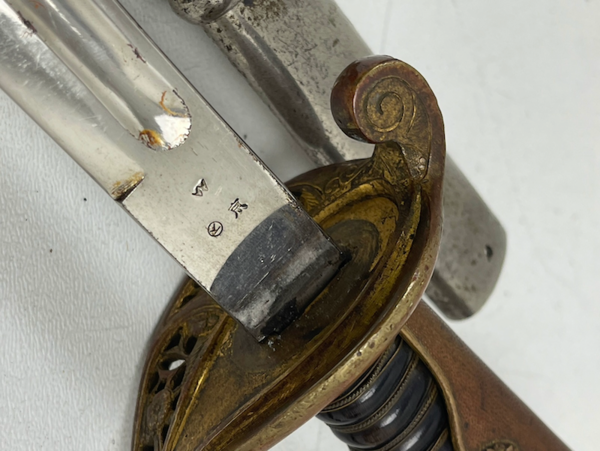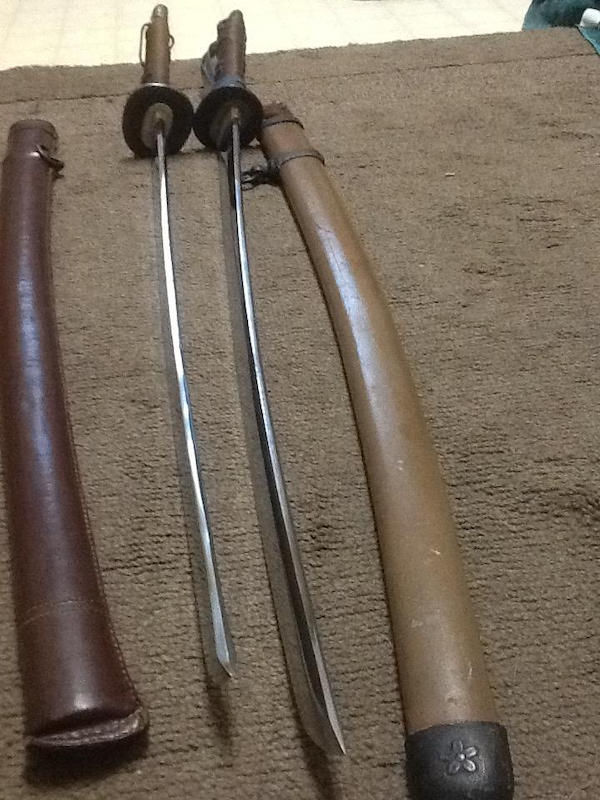
Conway S
Gold Tier-
Posts
441 -
Joined
-
Last visited
-
Days Won
1
Content Type
Profiles
Forums
Events
Store
Downloads
Gallery
Everything posted by Conway S
-
Curious case of gunto 23rd Kanefusa sold on ebay.
Conway S replied to Rawa's topic in Military Swords of Japan
@Rawa Here is an example: Small Seki and star stamps. The large seki stamp is the one associated with showato. The small seki is an arsenal inspection stamp, like the 名- na stamp. -
Anything on the nakago mune? I’ve viewed two in-hand and both had a sho stamp. The price wasn’t to my liking so I passed on them… hoping to have better luck next time. Congrats on the pick up! edit: May have been the Seki stamp I observed.
-
Potential Pawn Shop Purchase - Two Type 97s
Conway S replied to Kaigunto230's topic in Military Swords of Japan
I would say if you have $3,000 to spend on swords and you want to be selective in what you are buying, I’d either save your money for something nicer or buy just one of the two. Something better always comes along…. -
@Nicholas Does your Kanefusa have a “Sho” stamp? Can you share pictures of the blade and nakago? @Bruce Pennington Does the stamp document attribute the star stamp on the fittings to the Shoheikan Kabushiki Kaisha shop?
-
Potential Pawn Shop Purchase - Two Type 97s
Conway S replied to Kaigunto230's topic in Military Swords of Japan
@Kaigunto230I didn’t realize the second sword had two haikan since the initial pictures only showed one. I wouldn’t categorize it as rinji based on the tsuka alone. I’ve been to many pawn and gun stores where the owners don’t seem to like to money and it leads me to wonder how they stay in business. I’m inclined to change my tune now that I see your latest photos of sword number two. -
Thanks, Thomas! I forgot about that thread. It contained the info I was looking for and the clarification that the stamp is 京 not 東.
-
curious about a smith and open for discussion
Conway S replied to Mike Noel's topic in Translation Assistance
If the sword is in bad shape as your initial post suggests and you cannot see the blade, I would definitely save your money. -
I found another parade sword with 東- “to” on the ricasso. There’s a few other examples found within this thread, but I did not see any speculation that Tokyo Arsenal was inspecting army contract parade swords. Maybe the accompanying encircled characters are production prefixes?
-
Potential Pawn Shop Purchase - Two Type 97s
Conway S replied to Kaigunto230's topic in Military Swords of Japan
If the pawn shop was only asking $1,000 each and they won’t split them up, you would definitely recoup your money on the second sword or make a profit if you wanted to sell it. -
Potential Pawn Shop Purchase - Two Type 97s
Conway S replied to Kaigunto230's topic in Military Swords of Japan
Personally I don’t believe the second sword looks like a Takayama-to. Their distinctive kissaki is quite beefy. Here is a comparison photo that @Bruce Pennington once posted: Here’s more good info on Tenshozan and anti-rust steel: http://ohmura-study.net/731.html And some threads that may help you understand the fittings on the second sword: -
Michael, It’s signed Tenshozan Tanrenjo saku and dated a lucky day in February 1942. Lots of information on this forge in Mal Cox’s naval sword articles in the download section.
-
The second one from the top was on another Formosa colonial officials sword if I recall correctly. I found it on Live Auctioneers.
-
I agree with Ray. Those are just sub-assembly numbers. I don’t see anything from the pictures provided that would tie this to Korean use or production.
-
Roger, One thing you should check on is whether a Seki-stamped blade can be imported to Japan. They seem to still occupy a legal gray area. If it can’t be imported it might be destroyed before it even gets to a potential family member. The Japanese embassy folks might be under the impression you are trying to return an actual antique sword.
-
The stamp looks like 越 which could be pronounced “koshi.” I might be very off with pronunciation since I have no formal training in spoken Japanese
-
Sam, I don’t think the green marking partially obscured by the seppa would be a duplicate maker or inspection stamp. I think it could be a sub-assembly number as I have seen these on guards before in the form of Arabic numerals and katakana.
-
Tobi, Don Schlickman in the US makes reproduction parts for Type 95s. I don’t know if he could mail to NZ, but might be worth contacting him. https://www.nambuworld.com/donspartslist.htm
-
The black steel tsuba appear in numerous serial ranges. It’s a misconception that these tsuba are later production than the brass ones. Also when swords were refurbished during the war, parts including the tsuba were replaced.
-
But why post it in the fake thread? It’s not fake… just repainted.
-
Does it have two mekugi ana?
-
Alex, This is a Takayama-to made by Miwa Mitsugu Ujinaga. See the attached with examples of this particular mei:
-
I understand the PSA about fake swords, but this seller makes it clear in the description this is not an authentic sword. Top Grade 98 Officer's Saber Japanese Gunto Clay Tempered Folded Steel Sword Fittings: Brass,itMaterial: Damuscus folded 1095 steel + clay tempered Craft: Fully hand folded and forged by 15 times(32768 layers),clay tempered,traditional quench treatment,and hand-polishing,etc. Overall Length:103cm / 40.6 inches Nagasa Length:72cm / 28.3 inches Handle Length:26cm / 10.2 inches Width: 1.26''/3.2cm Thickness: 0.28''/0.7cm Bo-hi: No blood groove Fittings: Brass,it won't fade Hardness(HRC): 60 Saya: Iron saya+Brown Real Leather Rayskin: Real shark rayskin Notice: 1-A free&random sword bag comes with the sword 2-The display stand is NOT included 3-Due to All of our products are full handmade,So the specification varies a little from sword to sword. The 1095 steel reference alone should tell someone this is a modern item…. Plus you can buy more than one at a time. Check out this link. All of this seller’s swords are junk meant to deceive. Although shipping from California, if you click on the seller’s details, it says they are located in China... WWII Japanese Samurai Sword SHIN GUNTO TYPE 98 World War 2 KATANA WW2
-
There’s a thread here for Mon identification help.
-
These gray area swords are tricky and personally I would avoid them entirely if you are looking for a genuine WW2 Japanese sword. If you want an “occupation made” or “island sword” for your collection, then go ahead and roll the dice.
-
To Stegel’s point about the swapped tsuba, here is another example, but the seppa are correct for the the pattern 3: https://whartonmilitaria.co.uk/details.php?section=edgeweapons&item=EW0048





